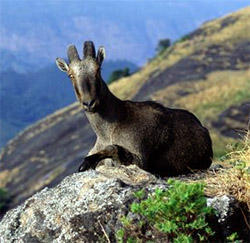Apr 13, 2025
Apr 13, 2025
by K. A. Shaji
A road project linking Gudalur with Sathyamangalam bypassing Ootty and a railway line connecting nearby Wayanad and Malappuram in Kerala with Nanjangud in Karnataka are on the active consideration of Union Government and if implemented once, they would wipe out the remaining flora and fauna of the blue hills. Efforts to establish a gigantic neutrino research station with an underground laboratory and a surface lab at Singara near Massinagudi within Muthumalai Wildlife Sanctuary are also fast progressing giving a strong indication that the rich biodiversity of the region is not safer. The major hills are the Nilgiri, Nilambur and Siruvani hills. The elevation ranges from 300 metres to 2700 metres above mean sea level. The highest point is Doddabetta at a height of 2,636 metres. Several rivers either flow through the Nilgiris or originate there ' Pykara, Moyar, Bhavani, Chaliyar, Kodalundi, Bharathapuzha, Noyil, Kundah, Suvarnathi and Lakshmana tirtha. The Nilgiris is home to the last tropical forests and rainforests of South India. The rocks and boulders that make up the hills are held together by soil. When trees are cut down, their roots are no longer available to hold the soil together. A heavy rainfall is sufficient to make the rocks and boulders come hurtling down. Tea and vegetable plants are totally inadequate in preventing landslides. Several development projects rang the death knell for the Nilgiris. Locating the Hindustan Photo Films in the Nilgiris was a suicidal and ridiculous attempt by former Prime Minister Jawaharlal Nehru. It is a resource-guzzling white elephant. Thousands of hectares of forestland and grasslands were destroyed to build the factories and the homes for the staff, an unnecessary effort as the company (a PSU) died a natural death. The relocation of the repatriate Tamils from Sri Lanka in the Nilgiris following the Sirimavo Bandarnaike-Lal Bahadur Shastri pact was another act of suicide, as the population shot up, resulting in the establishment of TANTEA to provide them work by converting more forest land to tea gardens. Neither the repatriates nor the ecology benefited from that attempt. The Pykara Ultimate Stage Hydro Electric Project (PUSHEP) was yet another disaster. Apart from the expansion of the hydroelectric project in prime forestland, 7000 people were settled in Masinagudi and transported daily to PUSHEP across the elephant corridor. Companies like the Government Cordite Factory, Protein Products India and Needle Industries have also contributed to the degradation of the Nilgiris, by the conversion of forest to factories and the pollution of air, land and water. The consequent population pressure has created slums out of the beautiful hill stations of Ooty and Coonoor. The destruction of wildlife is unforgivable. It all started with the trigger-happy British hunters, followed, after Independence, by trigger-happy Indian poachers. Habitat loss, increases in population, and pressure on land, water and other natural resources have made the tiger a rarity, the tusker impossibility. The elephant corridor is heavily encroached, making migration extremely difficult for these huge pachyderms. Poaching has taken a heavy toll of wildlife.  It's no more the queen of hills. Not much blue mist in the air and the numerous picturesque valleys have turned into ugly eucalyptus plantations or concrete jungles. Most of the majestic waterfalls and streams have dried up. Rare plants and trees are fast vanishing as the climate has changed a lot.
It's no more the queen of hills. Not much blue mist in the air and the numerous picturesque valleys have turned into ugly eucalyptus plantations or concrete jungles. Most of the majestic waterfalls and streams have dried up. Rare plants and trees are fast vanishing as the climate has changed a lot.
Nilgiris, the summer retreat of British Raj in the then Madras Presidency, now holds not much promise either to its residents or to those who visiting it once in a while. It only has a dying legacy to tell. Forget both Ooty and Coonoor, destroyed by the tourism mafia in their bid to make easy money by throwing all rules and regulations to the wind. Even other destinations like Gudalur and Kotagiri are under the tight hold of land sharks and mafia groups. Deforestation is rampant and the exodus of repatriates, refugees and migrants is still continuing.
Repatriate Indian Tamils from Sri Lanka, refugees who left the island nation following the escalation of ethnic strife and Malayalee migrant farmers from Southern Kerala are still remain the aggrieved lot in Nilgiris though vast stretches of forest land were destroyed for their rehabilitation and crores of public money were wasted in the name of their welfare. The grass lands and sholas, the twin eco-system of the Nilgiris, are also under threat at the hands of film production units, which have little care for the conservation of the real beauties of the hills.
Going by the history, century-old Nilgiri Mountain Railway had sounded the death knell of the hills first. The Madras Railway Company, a British firm, had completed the first stretch from Mettupalayam to Conoor in 1899 while Ooty was connected by 1908. A journey in it is unique and exciting as it is the only train in India that runs on a special rack provided centrally between the track rails. The 45-kilometre journey climbs steep gradients, over waterfalls and streams, passing through thick jungle, long tunnels, ravines, gorges and cliffs.
Before the arrival of the train, it was a long and arduous task to climb the hills on horseback, with bullocks whipped into pulling goods over a long and slow trek through the hills. The road and train made the journey easy and the destruction of the hills inevitable. British greed and Indian complicity did the rest.
John Sullivan, Collector of Coimbatore, is credited with the discovery of the Nilgiris, specifically Ooty, in 1819. But people have lived here for ages and human remains in the Nilgiris have been dated to 10,000 B.C.
Neolithic sarcophagi, the Eluthu Paarai rock paintings of 3000 B.C. and the mysterious Edakkal Cave inscriptions are among the earliest archeological remains found in South India. The descendants of those people are the colourful Toda, Kota, Kurumba, Irula and Paniya tribes and their subsidiaries, and the more agricultural Badagas.
According to experts, Nilgiris is undoubtedly an excellent case for study of inter-tribal relationships. The Todas bred buffaloes that supplied the milk, the Kotas were potters, ironsmiths and carpenters, Kurumbas were the magico-religious sorcerers, Irulas were herbal doctors and the Paniyas were slaves and bonded labourers. The Badagas were related to the Lingayats of Karnataka and brought the science of agriculture to the hills. Each tribe performed its exclusive role in the barter economy, besides eschewing inter-tribal marriages and even communal feasting.
The tribes preserved the pristine beauty of the hills through millennia. Yet, in the 120 years or so since the British went up the hills, the Nilgiris have become an environmental hotspot. What happened?
The Nilgiris (Neela Giri or Blue Mountains) are so-named because of the blue mist that used to envelops them and because of the kurinji (Strobilanthes kunthianus) flower, a tall bushy scrub eight to ten feet high with bright blue bell-like flowers that bloom once in twelve years and cover the hills in a blue haze. The Nilgiris are rich in plant diversity and about 3000 varieties of flowering plants have been identified here. Of the identified species of animals are 74 mammals, 342 birds, 120 reptiles and 49 amphibians, besides many butterfly and insect species. The unidentified probably runs into thousands.
The Nilgiris were the first to be declared a Biosphere Reserve in 1986, an area of 5520 sq. kms. A biosphere reserve is a protected area with a unique environment and ecology. There are several reserve forests such as Nilambur, Kallar, Sirumugai, Siruvani Sigur and Singara; sanctuaries such as Wynad, Nagarhole and Mudumalai; and national parks such as Silent Valley and Bandipur.
The declaration of the NBR has not contained the degeneration of the Nilgiris. The major problem is deforestation. Vast stretches were denuded of their green cover. Between 1849 and 1992, the sholas decreased from 8,600 hectares (ha) to 4,225 ha, grasslands from 29,875 ha to 4,700 ha. The timber was used for the railway sleepers during the British period, and, till today, for construction, furniture, paper, fuel and fuelwood for the tea industry. The cutting of trees and destruction of forests has resulted in habitat loss for wildlife and soil erosion, the rains washing away the rich topsoil year after year.
 Another problem with the hills is the tea industry. It was in fact Sullivan who introduced tea in the Nilgiris, but it was only after 1865 that tea cultivation became important. Today, nearly 16,900 ha are under tea cultivation, served by highly polluting factories that process the tea and, in the process, pollute the pure Nilgiri air. By law, tea must be planted on slopes of above 330, but this law is easily flouted. Unfortunately, while tea gardens look green, they do not encourage the existence of a natural ecosystem. The land under cultivation for 'English' vegetables has also gone up, to over 12,400 ha. All these plants have short inadequate roots, leading to an increase in the number of landslides.
Another problem with the hills is the tea industry. It was in fact Sullivan who introduced tea in the Nilgiris, but it was only after 1865 that tea cultivation became important. Today, nearly 16,900 ha are under tea cultivation, served by highly polluting factories that process the tea and, in the process, pollute the pure Nilgiri air. By law, tea must be planted on slopes of above 330, but this law is easily flouted. Unfortunately, while tea gardens look green, they do not encourage the existence of a natural ecosystem. The land under cultivation for 'English' vegetables has also gone up, to over 12,400 ha. All these plants have short inadequate roots, leading to an increase in the number of landslides.
In addition, the alien wattle and eucalyptus trees cover over 9,775 ha and 5,150 ha respectively. Their prime purpose has been to supply raw material for South India Viscose, who held a 99-year lease. Nothing grows beneath these trees, which have only served to drive away the natural wildlife, and drunk up the ground water reserves.
Life is not a cozy affair for the original tribal inhabitants of the Nilgiris as well. Alcoholism is rampant and their population is decreasing. Their ancient inter-tribal barter system has broken down and they lack the skills to make them employable. With the exception of the Badagas who are educated and prosperous, the rest have been dispossessed of their land. They have become objects of curiosity for gawking tourists, but have been unable to derive any benefit from the tourism industry, unlike locals elsewhere. Governments and the people have destroyed the Nilgiris in their greed to exploit its resources and treasures. But the Nilgiris are the major watershed for South India, serving three states. If they go, so will our biodiversity, our natural resources, our water catchments, our life giving rains. The survival of the South is heavily dependant on the Nilgiris.
17-Jun-2007
More by : K. A. Shaji